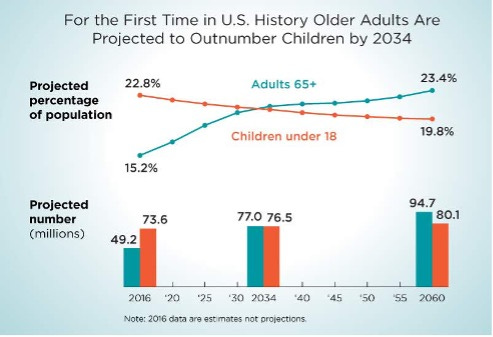The Silver Surge
Catalyzed by the graying of our population, there is a massive shift occurring within health towards more innovative and holistic models of care.
Our population is aging at a rapid pace, which is having a profound impact on our workforce and society. By 2030, 1 in every 5 Americans will be of retirement age. 1 in 10 people in Japan are aged 80 or older. By 2050, the world’s population of people aged 60 years and older will double (2.1 billion). The shift started in high income countries and is now permeating across the globe. Given the advances in healthcare and industrialization of the modern world, our lifespans have increased drastically over the past century. Countries are facing major challenges to ensure the health of their populations and social systems are prepared for this shift in demographic. This shift has put immense pressure countries like the U.S. where public health and retirement systems are in danger due to rising costs and decreases inflows.
What’s important to note is that the healthcare burden of the elderly is negatively correlated with economic growth. One study showed that each 1% increase in healthcare burden led to a 0.08% decrease in GDP growth rate, emphasizing the economic implications of an aging population. Rising costs of healthcare and decrease in labor force can have profound impacts on society, specifically in countries like the U.S. where the elderly are dependent on government programs for health insurance. The Medicare population is expected to reach just under 70 million by 2030, increasing its acute annual care costs to more than $250 billion. Medicare now accounts for over 21% of national health spending and 10% of the federal budget and is only going to increase as a result of the rapidly aging population.
In order to combat these rising costs and the increasing number of individuals needing care in their old age, it is crucial that the healthcare industry continues to innovate, adopting alternative care models designed to cut costs and prevent provider burnout. Digital health innovation has been crucial in the development of virtual care and preventative care that can help alleviate the challenges of capacity, accessibility, and longer lifespans amongst the population. For the elderly, digital health presents an opportunity to manage chronic conditions, monitor vital signs, and access medical expertise from the comfort of their own homes, giving rise to the idea of “aging in place”. As the world’s demographics shift and the elderly begin to adopt more innovative modes of care, we see vast opportunities for early-stage startups venturing into the age tech space.
Age tech has become a huge topic of conversation in the venture world as companies look to build digital tech around the needs and wants of the elderly population. With a focus on improving the quality of life in old age, decrease dependence on the healthcare system, and encourage individuals to be independent for longer, age tech can help alleviate some of the pressures felt with the demographic shift we are seeing in today’s society. These new tools are playing a crucial role in enabling the aging population by empowering them to age in place. Digital health and specifically age tech reduce barriers to care and help them maintain their health well into their old age. Telehealth, wearables, and smartphone applications are empowering adults to live longer, happier, and better lives while increasing access to the necessary care they need and helping them access and optimize government resources like Medicare and social security.
Top Trends in the Aging Population Space
Remote monitoring - The COVID-19 pandemic was a catalyst for the adoption of virtual and remote care, including telehealth services which have been increasingly adopted by older adults and their caregivers, improving accessibility and the ability to age in place. Rest Assured is a telecare and remote support company combining wireless monitoring and two-way video chat with specially trained caregivers to help the disabled and elderly population stay safe while living as independently as possible.
Wearable technologies – The wearables craze has completely dominated tech enabled consumer health in recent years, but our older population initially seemed less quick to adopt the trend. Wearables impact on remote monitoring of our aging population is massive and opportunities for incumbents and new entrants are vast. Companies like CareBand and Care Predict have created tailored wearable solutions for the elderly to aid in health and safety tracking leading to better independence. Apple has even entered the elder care market with features on their popular Apple watch that aim to predict and detect falls in seniors.
Adult physical fitness – There has been a heightened focus on physical fitness and the importance of muscle building even in old age. (see my previous article on the importance of weight training for more info) A handful of startups in the space emerged in recent years, Bold, Balanced, Healing Innovations to name a few, aimed at providing access to digital workouts, on demand fitness trainers, innovative physical therapy, and high-tech rehab to the elderly population
Provider tools – The digital health revolution has also allowed providers of elder care to scale their practices quickly and better track progress, aggregate patient data, organize programs and events, manage billing, and more. Platforms such as Mon Ami and Mabel Care, specifically help streamline care and improve the aging at home network.
Sensor and voice technologies – Utilizing AI, voice command, and cameras, many tools have emerged to help both the disabled population and aging population navigate everyday life easier while improving social interactions and connectivity in isolated populations. Ava is working to reduce the burden on hard of hearing populations by offering AI powered captions in real time. KamiCare uses video technology to detect falls and automate 911 dispatch for seniors living alone, offering a home security solution for the most vulnerable population.
As you can see, the age tech sector is extremely promising as our population gets older and healthcare costs rise, there is immense opportunity for companies to utilize digital tools, hardware innovation, and AI to help improve quality of life for the soon to be largest demographic. Projections estimate the sector to reach more than $2.7 trillion by 2025, indicating a rapidly growing field of supporting healthy aging through technology. Through innovations in telehealth, smartphone apps, and wearable devices age tech helps empower older adults to live longer, healthier, and more connected lives. And as we lose a large portion of our society to retirement, technological innovations can help alleviate the burden of elder care from our working population, while also improving the quality of care received by our older cohorts.







